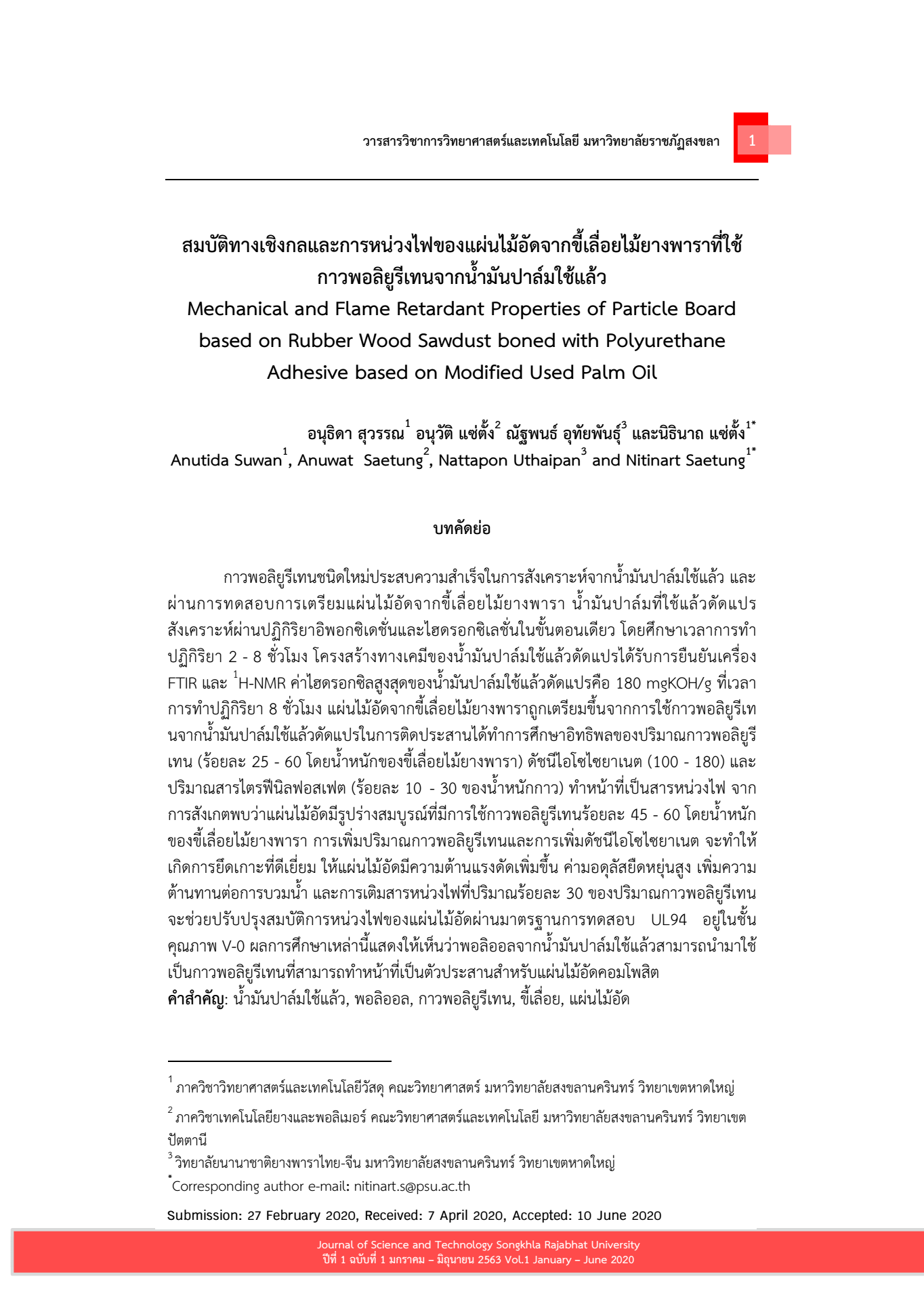Properties of Fiberboard based on Rubber Wood Sawdust boned with Polyurethane Adhesive based on Modified Used Palm Oil
สมบัติของแผ่นไม้อัดจากขี้เลื่อยไม้ยางพาราที่ใช้กาวพอลิยูรีเทนจากน้ำมันปาล์มใช้แล้ว
Keywords:
Used palm oil, Polyol, Polyurethane adhesive, Sawdust, ParticleboardAbstract
Novel polyurethane adhesive was successfully synthesized from used palm oil (UPO) and was further tested for preparing particleboard based on rubberwood sawdust. Modified used palm oil (MUPO) was synthesized via epoxidation and hydroxylation in a single step. The reaction time of 2-8 hours was studied. The chemical structure of MUPO was confirmed by FTIR and 1H-NMR spectroscopy. The highest OH value of MUPO was 180 mgKOH/g with 8 h of reaction time. The new particleboard based on rubberwood sawdust bonded with polyurethane adhesive based on used palm oil was prepared. The effects of polyurethane adhesive content (25 – 60 %wt of rubberwood sawdust), NCO index (100 -180), and Triphenyl phosphate content (10 – 30 %wt of adhesive) used as flame retardant were investigated. It was observed that the particle board had a perfect shape with a range of polyurethane adhesive 45 – 60 % wt of rubberwood sawdust. Increasing the polyurethane adhesive content and increasing the NCO index gave an excellent binding with a high bending strength, the high elastic modulus of particle board, and increasing water resistance. Moreover, adding flame retardant 30 %wt of adhesive improved flame retardant properties of the composite board with pass the UL-94 for the V-0 test. These results demonstrated that polyol based on used palm oil can be used as adhesive polyurethane that can serve as a binder for composite particleboard.
References
Arts, J. H. E., Rennen, M. A. J., De Heer, C.(2006). Inhaled formaldehyde: Evaluation of sensory irritation in relation to carcinogenicity. RegulatoryToxicology andPharmacology.44 (2), 144-160.
Badri, K. H., Mat Amin, K. A., Othman, Z., Manaf, H. A., Khalid, N. K. (2006). Effect of filler-to-matrix blending ratio on the mechanical strength of palm-based biocomposite boards. Polymer International. 55 (2), 190-195.
Cui, S., Luo, X., Li, Y. (2017). Synthesis and properties of polyurethane wood adhesives derived from crude glycerol-based polyols. International Journal of Adhesion and Adhesives. 79, 67-72.
Gupta, M., Monika, C., Khatoon, N., Singh, B. (2010). Composite boards from isocyanate bonded pine needles. Journal of Applied Polymer Science. 118 (6), 3477-3489.
Hermawan, A., Ohuchi, T., Fujimoto, N. (2011). Manufacture of three-layer wood–porcelain stone composite board reinforced with bamboo fiber. Materials & Design. 32 (4), 2485-2489.
Kamel, S., Adel, A. M., El-Sakhawy, M., Nagieb, Z. A. (2008). Mechanical properties and water absorption of low-density polyethylene/sawdust composites. Journal of Applied Polymer Science. 107 (2), 1337-1342.
Malik, M., Kaur, R. (2018). Mechanical and Thermal Properties of Castor Oil–Based Polyurethane Adhesive: Effect of TiO2 Filler. Advances in Polymer Technology. 37 (1), 24-30.
Nuñez, A. J., Aranguren, M. I., Berglund, L. A. (2006). Toughening of wood particle composites-Effects of sisal fibers. Journal of Applied Polymer Science. 101 (3), 1982-1987.
Riyapan, Duangporn., Saetung, Anuwat., and Saetung, Nitinart. (2019). A Novel Rigid PU Foam Based on Modified Used Palm Oil as Sound Absorbing Material. Journal of Polymers and the Environment. 27, 1693-1708.
Suoware, T. O., Edelugo, S. O., Ezema, I. C. (2019). Impact of hybrid flame retardant on the flammability and thermomechanical properties of wood sawdust polymer composite panel. Fire and Materials. 43 (4), 335-343.
Shen, T., Lu, M., Liang, L., Zhou, D. (2012). Mechanical and thermal properties of eucalyptus fiber composites bonding by blocked polyurethane adhesive. Journal of Applied Polymer Science. 125 (2), 984-991.

Downloads
Published
How to Cite
Issue
Section
License
Attribution-NonCommercial-NoDerivatives 4.0


